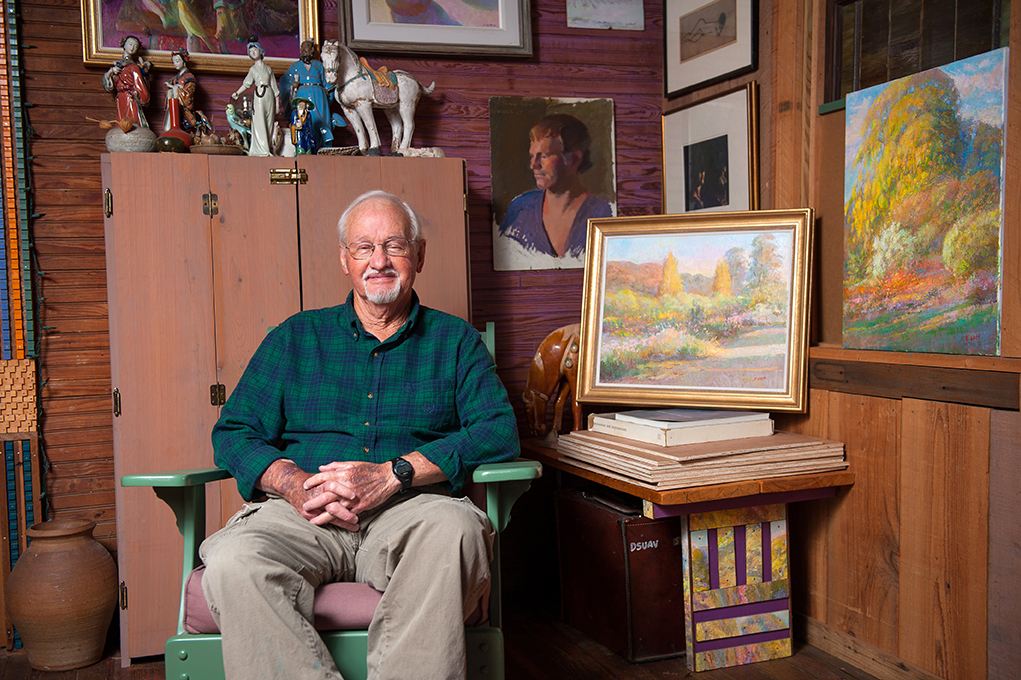Sammy Britt’s studio sits a few miles north of Cleveland, surrounded by farmland and a classic Delta bayou. He often paints outdoors and has watched, since 1996, new homes sprout in the fields where cotton did before. The studio, too, has changed — what was once a derelict tenant shack with no heat and no indoor plumbing has become a cozy retreat. Britt and his wife, Linda, stay there when family visits their home in town. The Britts have three children and seven grandchildren.
Painted in pastel colors, ornamented with dentil molding (in some cases, even with scraps of Britt’s paintings), the studio is like nowhere else in the Delta. And yet, it does not feel out of place. It is the product not of whimsy and imagination, but of looking into the world and seeing clearly what is there —and what belongs.
Britt, born in 1940, grew up in Ruleville in the back of a grocery store that his family owned. He was a doodler — he repeated first grade in part because he spent too much time drawing — although his early artistic inspirations, including Norman Rockwell and comic books, might not suggest the sort of art he creates today.
That style emerged intact in 1963 when Britt was a 23-year-old art student at the Memphis Academy of Art. He scraped together enough money to spend a summer in Provincetown, Mass., at the Cape Cod School of Painting, studying with an artist/teacher about whom one of Britt’s professors at the Memphis Academy of Art raved.
That teacher, Henry Hensche, may be better known among professional artists than casual art fans. But Britt describes him as a rare, true innovator. Hensche is, Britt said, the sole painter to move the art movement beyond the developments of Realism and Impressionism. He had a new way of seeing the world.
It all comes down to light — and to what Britt calls the “visual truth.” It’s a truth that one is not simply born seeing.
“Everyone knows we have to be taught to talk,” Britt said. “Well, we also have to be taught to see light and color.”
Indeed, Hensche taught vision like language, emphasizing three elements: light, color and shape. That order matters, said Britt.
“Light enables us to see the color, and the color lets us see the shape,” Britt said.
Artists get trapped, he said, when they focus too much on their subject, the composition, even their imagination. It’s the light itself that gives life to a work of art — capturing a particular quality of light at a particular time of day, in a particular time of year. Each of these moments has its own “light key,” which establishes a set of relationships between colors.
After painting with Hensche, Britt said, the world could never again be dull. His new practice required looking deeply, setting aside preconceived notions — and truly taking account of what is before one’s eyes.
“Sparring with nature,” Britt said, “you’re not going to win. But you walk away with at least a feeling of ‘I learned something.’”
In order to study with Hensche, Britt repeatedly returned to Cape Cod and, later, to Louisiana, after Hensche moved. But even after his first summer, it was clear how he wanted to paint — a style that, in the mid-1960s, was out of step with the trends of abstraction and pop art.
That first summer also made clear that he wanted to teach, and how he wanted to teach. Britt’s step-by-step program is modeled after Hensche’s and requires students to master one element of vision before moving to the next.
Britt began teaching at Delta State University in 1966, after completing an MFA at the University of Mississippi, and stayed until he retired in 2002. Through that long tenure, and through his many workshops across the state, Britt has deeply influenced the contemporary art scene in the state. That influence perhaps was best displayed at a 1999 exhibition at the Lauren Rogers Museum of Art in Laurel. It included a lineage of artists, beginning with Hensche’s own mentor, Charles Webster Hawthorne, descending through Britt, and concluding with three of Britt’s own students. All were inspired by his influence to travel to Cape Cod and study under Hensche, as well.
It’s such influence that Britt credits with his recent accumulation of awards. Last year, he received a Lifetime Achievement Award from the Mississippi Institute of Arts & Letters. This month, he will receive a Governor’s Arts Award for Excellence in Visual Arts.
“The honor is really to those I have taught,” he said. “They’re the ones being recognized.”
Britt said that teaching has made him a better painter and, while his paintings bring value into the world by helping viewers find beauty, teaching is far more valuable. Britt instills in his students the idea that each has a God-given talent.
As Britt sits in his studio, sharing his story, collections of knick-knacks sit near the two north-facing windows, bathed in the lengthening afternoon light. Once the items and their arrangement seem right to him, they will become the subjects of indoor still-life paintings.
“In our greatest artistic moment, we can merely create a weak illusion of God’s great creative genius, but that tiny glimpse of God’s beauty is more than enough to share with another soul,” Britt said.
Photos by Rory Doyle

